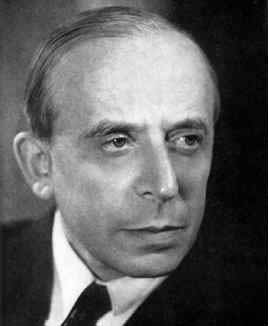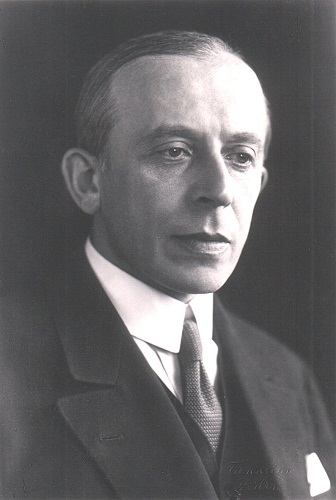<Back to Index>
- Mathematician Richard Edler von Mises, 1883
- Painter Heinrich Maria von Hess, 1798
- Luftwaffe Colonel Erich Alfred "Bubi" Hartmann, 1922
PAGE SPONSOR


Richard Edler von Mises (19 April 1883, Lemberg – 14 July 1953, Boston, Massachusetts) was a scientist and mathematician who worked on solid mechanics, fluid mechanics, aerodynamics, aeronautics, statistics and probability theory. He described his work in his own words shortly before his death as being on
- "... practical analysis, integral and differential equations, mechanics, hydrodynamics and aerodynamics, constructive geometry, probability calculus, statistics and philosophy."
Although best known as one of the most significant mathematicians of the century, he also contributed to the philosophy of science as a neo-positivist, following the line of Ernst Mach. Historians of the Vienna Circle of logical empiricism recognize a "first phase" from 1907 through 1914 with Philipp Frank, Hans Hahn, and Otto Neurath. His elder brother, Ludwig von Mises, held an opposite point of view with respect to positivism and epistemology. During his time in Istanbul, von Mises maintained close contact with Philipp Frank, a logical positivist and Professor of Physics in Prague until 1938. His literary interests included the Austrian novelist Robert Musil and the poet Rainer Maria Rilke, on whom he became a recognized expert.
Richard
von
Mises was born in Lemberg,
then
part of the Austria-Hungary (now Lviv, Ukraine),
into
a Jewish
family 18 months
after his brother, the Austrian
School economist Ludwig
von
Mises. His father was Arthur Edler von Mises, a doctor of
technical sciences who worked as an expert for the Austrian State
Railways and Adele von Landau. Richard and Ludwig also had a younger
brother, who died as an infant. Richard attended the Akademisches
Gymnasium in
Vienna, from which he graduated with honors in Latin and mathematics in Autumn
1901. After graduating in mathematics, physics and engineering from the Vienna
University
of Technology, he was appointed as Georg
Hamel's assistant in Brünn (now Brno).
In
1905, still a student, he published an article on "Zur konstruktiven
Infinitesimalgeometrie der ebenen Kurven," in the prestigious Zeitschrift für
Mathematik und Physik. In 1908
Mises was awarded a doctorate from Vienna (his dissertation was on "the
determination of flywheel masses in crank drives") and he received his
habilitation from Brünn (now Brno)
(on
"Theory of the Waterwheels")
to
lecture on engineering. In 1909, at 26, he was appointed professor
of applied mathematics in Straßburg, then part of the German
Empire (now Strasbourg, Alsace, France)
and
received Prussian citizenship.
While
applying for teaching positions at the Brno
University
of Technology, this was interrupted by World
War
I. A pilot
who had lectured on the design of aircraft and given in Straßburg
the first university course on powered flight in 1913, he then joined
the Austro-Hungarian army and flew as a test
pilot and an
instructor. In 1915, he supervised the construction of a 600-horsepower (450 kW)
aircraft
— the "Mises-Flugzeug" (Mises aircraft) for the Austrian army.
It was completed in 1916, but never saw action. After the
war Mises held the new chair of hydrodynamics and aerodynamics at the Dresden Technische
Hochschule.
In 1919 he was appointed director (with full professorship)
of the new Institute of Applied
Mathematics created
at the behest of Erhard
Schmidt at the
University of Berlin. In 1921 he founded the journal Zeitschrift
für
Angewandte Mathematik und Mechanik and became its editor. With the
rise of the National
Socialist (Nazi)
party to power in 1933, von Mises, felt his position threatened despite
his World War I military service. He moved to Turkey,
where
he held the newly created chair of Pure and Applied Mathematics
at the University of
Istanbul. In 1939 he accepted a position in the United
States, where he was appointed 1944 Gordon-McKay Professor of
Aerodynamics and Applied Mathematics at Harvard
University. He married Hilda
Geiringer in 1943,
who had been his assistant at the Institute and followed him to Turkey
and then to the U.S. after losing her position in December 1933. In 1950
Mises declined an offer of honorary membership from the Communist-dominated East
German Academy of
Science. In
aerodynamics, Richard von Mises made notable advances in
boundary-layer-flow theory and airfoil design. He developed the Distortion energy
theory of stress,
which
is one of the most important concepts used by engineers in material strength calculations. His ideas
were not unanimously well received, although Alexander
Ostrowski had said
of him: and also
wrote: Yet Kolmogorov,
whose
rival axiomatisation was better received, was less severe: In solid
mechanics, Richard von Mises made an important contribution to the
theory of plasticity by formulating what has
become known as the Von
Mises
yield criterion. He is also often credited for the Principle
of
Maximum Plastic Dissipation. The Gesellschaft
für
Angewandte Mathematik und Mechanik (International Association
of Applied Mathematics and Mechanics) has awarded a Richard
von
Mises-Preis (Prize)
since 1989. In probability
theory, he was the person who originally proposed the now famous "birthday
problem". He also defined the impossibility of
a gambling system.